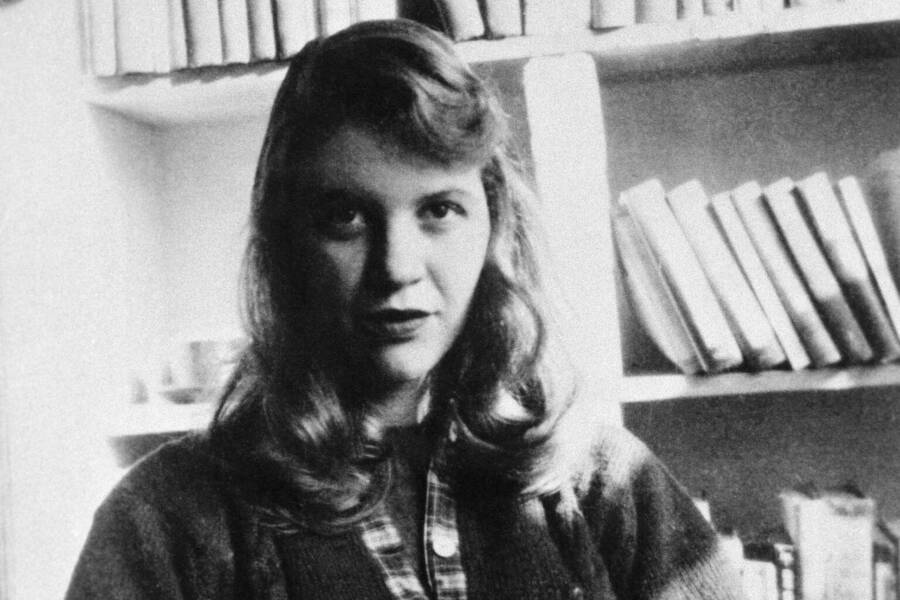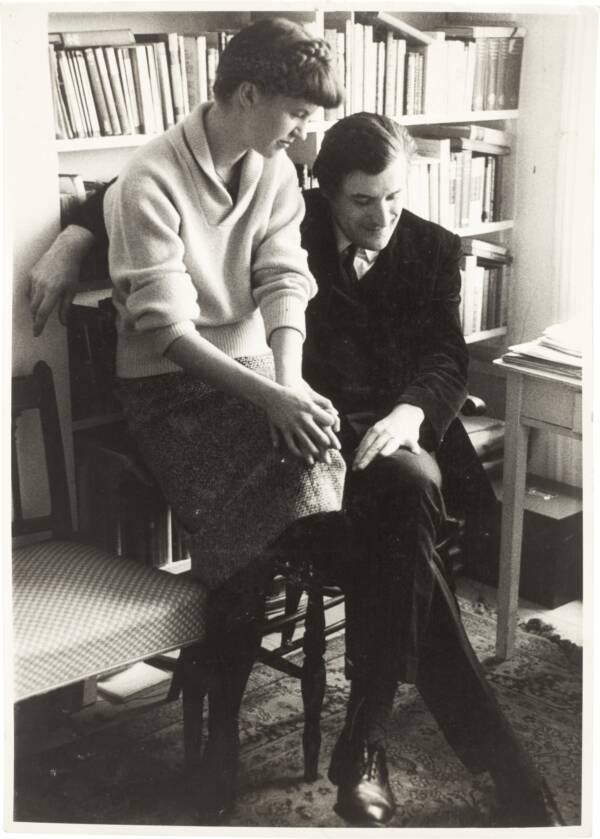Sylvia Plath died by suicide at the age of 30 on February 11, 1963, following a barrage of literary rejections and her husband's infidelity.

Bettmann/Getty ImagesSylvia Plath was just 30 years old when she died by suicide in London.
On a frigid night during one of the coldest winters in London’s history, a young poet named Sylvia Plath lay down in front of the oven and turned on the gas. Since then, Sylvia Plath’s death — and her morbid novel and collections of poems — have captivated generations of readers.
A gifted writer from a young age, Plath started writing and publishing poems before she’d even reached her teens. She attended Smith College, won a guest editorship at Mademoiselle magazine, and was awarded a Fulbright Grant to study at Cambridge in London. But beneath Plath’s sterling literary credentials, she struggled with severe mental health issues.
Indeed, Plath’s inner struggles seemed intertwined with her prolific prose. While rising through the literary ranks, Plath also suffered from severe depression that resulted in psychiatric care and suicide attempts.
By the time Sylvia Plath died in 1963, both her mental health and her literary career had reached a nadir. Plath’s husband, Ted Hughes, had left her for another woman — leaving Plath to care for their two children — and Plath had received a number of rejections for her novel, The Bell Jar.
This is the tragic story of Sylvia Plath’s death, and how the young and talented poet died by suicide at the age of 30.
The Rise Of A Literary Star
Born on Oct. 27, 1932, in Boston, Massachusetts, Sylvia Plath showed literary promise at a young age. Plath published her first poem, “Poem,” in the Boston Herald when she was just nine years old. More poetry publications followed, and an IQ test Plath took at the age of 12 determined that she was a “certified genius” with a score of 160.
But Plath’s early life was marred by tragedy, too. When she was eight years old, her father Otto died from diabetes. Plath had a complicated relationship with her strict father which she later explored in her poem “Daddy,” writing: “I have always been scared of you, / With your Luftwaffe, your gobbledygook.”

Smith College/Mortimer Rare Book RoomSylvia Plath and her parents, Aurelia and Otto.
And as Plath grew up, her literary gifts and inner darkness seemed to play dueling roles. While attending Smith College, Plath won a prestigious “guest editorship” at Mademoiselle magazine. She moved to New York City for the summer of 1953, but described her experience working and living in the city as “pain, parties, work” according to The Guardian.
Indeed, Plath’s inner struggles had begun to intensify. The New York Times reports that Plath had a mental breakdown following a rejection from a Harvard writing program, which the Poetry Foundation writes led the poet to attempt suicide at the age of 20 in August 1953. She then received electroshock therapy as treatment.
“It is as if my life were magically run by two electric currents: joyous positive and despairing negative—whichever is running at the moment dominates my life, floods it,” Plate later wrote, according to the Poetry Foundation.
Yet despite her struggles, Plath continued to excel. She won a Fulbright scholarship and moved to London to study at Cambridge University. And, there, Plath met her future husband, Ted Hughes, at a party in February 1956.
During their intense initial encounter, Plath bit Hughes’ cheek, drawing blood. Hughes later wrote of “the swelling ring-moat of tooth marks/That was to brand my face for the next month/The me beneath it for good.”

Sotheby’sSylvia Plath and her husband, Ted Hughes, had an intense and tumultuous relationship.
“It is as if he is the perfect male counterpart to my own self,” Plath wrote, according to History Extra. To her mother, she added that Hughes was: “the only man I’ve met yet here who’d be strong enough to be equal with — such is life,” according to the Washington Post.
But though they married after just four months and had two children together, Frieda and Nicholas, Plath and Hughes’s relationship swiftly soured.
Inside Sylvia Plath’s Death In London

Smith CollegeSylvia Plath showed literary promise from a young age but also struggled with depressive episodes.
By the time Sylvia Plath died in February 1963, her marriage to Ted Hughes had crumbled. He had left Plath for his mistress, Assia Wevill, leaving her to care for their two young children during one of the coldest winters in London since 1740.
But Hughes’ betrayal was just one of many of Plath’s problems. Not only was she dealing with relentless flu, but multiple American publishers had sent rejections for Plath’s novel, The Bell Jar, which was a fictionalized account of her time in New York and subsequent mental breakdown.
“To be quite honest with you, we didn’t feel that you had managed to use your materials successfully in a novelistic way,” an editor from Alfred A. Knopf wrote, according to The New York Times.
Another wrote: “With [the protagonist’s] breakdown, however, the story for us ceases to be a novel and becomes more a case history.”
Plath’s friends could tell something was off. As Plath’s friend and fellow writer Jillian Becker wrote for BBC, Plath was “feeling low.” Visiting Jillian and her husband, Gerry, on the weekend before she died, Plath expressed her bitterness, jealousy, and anger about her husband’s affair.
When Gerry drove Plath and her children home on Sunday night, she started to cry. Gerry Becker pulled over and tried to comfort her, even insisting that she and the children return to their home, but Plath refused.
“No, this is nonsense, take no notice,” Plath said, per Becker’s book Giving Up: The Last Days of Sylvia Plath. “I have to get home.”
The next morning, Feb. 11, 1963, Plath got up at around seven a.m. and tended to her children. She left them milk, bread, and butter so that they’d have something to eat when they woke up, put extra blankets in their room, and carefully taped the edges of their door.
Then, Plath went into the kitchen, turned on the gas, and lay down on the floor. Carbon monoxide filled the room. Before long, Sylvia Plath had died. She was only 30 years old.
Her family, ashamed of her suicide, reported that she’d died of “virus pneumonia.”
Sylvia Plath’s Enduring Legacy
Ted Hughes later wrote of hearing the news of Plath’s death: “Then a voice like a selected weapon/ Or a measured injection,/ Coolly delivered its four words/ Deep into my ear: ‘Your wife is dead.'”

Indiana University BloomingtonSylvia Plath died at the age of 30 in 1963 but her literary legacy has endured.
But though Sylvia Plath died on that frosty February morning in London, her literary legacy had just begun to bloom.
While the Bell Jar had been published in the United Kingdom under a pseudonym shortly before her death, it would not be published in the United States until 1971. And during the darkest days of her depression, Plath had produced a number of poems that would make up her posthumous collection, Ariel, which published in 1965.
Plath was also awarded a posthumous Pulitzer Prize in 1982. Today, she is considered one of the greatest female American poets of the 20th century.
Her legacy has not been without controversy, however. After Sylvia Plath’s death, her husband assumed control of her estate. According to History Extra, he later admitted to destroying parts of her journal. And Plath’s history of depression was apparently inherited by her son Nicholas, who died by suicide at the age of 47 in 2009.
Today, Sylvia Plath is remembered in two ways. Certainly, she’s remembered for her prolific creative output, which resulted in such works as The Bell Jar and Ariel. But Sylvia Plath’s death informs her legacy as well. Her despair, suicide, and bitter poems from that era are part of her larger legacy. The writer A. Alvarez wrote that Plath made poetry and death “inseparable.”
As the poet herself wrote in her poem “Lady Lazarus”:
“Dying/ Is an art, like everything else/ I do it exceptionally well/ I do it so it feels like hell.”
After reading about Sylvia Plath’s death, go inside the shocking suicide of Virginia Woolf. Or, read about the tragic suicide of Kurt Cobain, the Nirvana frontman who died at the age of 27.
If you or someone you know is contemplating suicide, call the National Suicide Prevention Lifeline at 1-800-273-8255 or use their 24/7 Lifeline Crisis Chat.





